
The Archdiocese of Bordeaux (–Bazas) is a Latin Church ecclesiastical territory or archdiocese of the Catholic Church in France. The episcopal see is Bordeaux, Aquitaine. It was established under the Concordat of 1802 by combining the ancient Diocese of Bordeaux with the greater part of the suppressed Diocese of Bazas. The Archdiocese of Bordeaux is a metropolitan see, with four suffragan dioceses in its ecclesiastical province: Dioceses of Agen, Aire and Dax, Bayonne, and Périgueux.
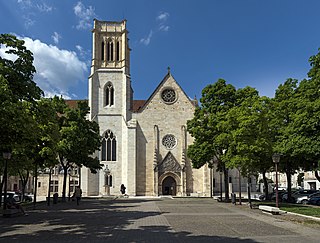
The Diocese of Agen is a Latin Church ecclesiastical territory or diocese of the Catholic Church in France.
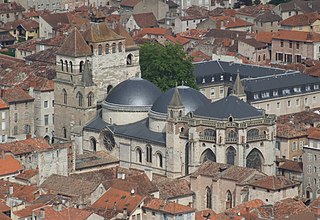
The Diocese of Cahors is a Latin Church diocese of the Catholic Church in France. The diocese comprises the whole of the department of Lot.

The Diocese of Vannes is a Latin Church diocese of the Catholic Church in France. Erected in the 5th century, the Episcopal see is Vannes Cathedral in the city of Vannes. The diocese corresponds to the department of Morbihan, and is suffragan to the Archdiocese of Rennes, Dol, and Saint-Malo. Raymond Michel René Centène is the current bishop since his appointment in 2005.

The Diocese of Tarbes et Lourdes is a Latin Church ecclesiastical territory or diocese of the Catholic Church in France. Until 2002 Tarbes was a suffragan of the Archdiocese of Auch. It is now a suffragan of the Archdiocese of Toulouse.
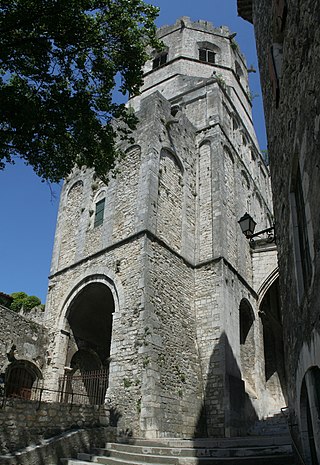
The Diocese of Viviers is a Latin Church diocese of the Catholic Church in France. Erected in the 4th century, the diocese was restored in the Concordat of 1822, and comprises the department of Ardèche, in the Region of Rhône-Alpes. Currently the diocese is a suffragan of the Archdiocese of Lyon. Its current bishop is Jean-Louis Marie Balsa, appointed in 2015.

The former Catholic diocese of Maillezais in north-west France was erected in 1317, by Pope John XXII, and ceased to exist in 1648 when it was incorporated into the new diocese of La Rochelle. The town of Maillezais is now found in the department of Vendée, and most of the territory of the former diocese belongs to the diocese of Luçon.
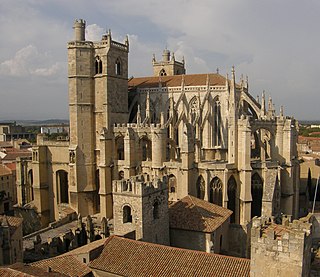
The former Catholic diocese of Narbonne existed from early Christian times until the French Revolution. It was an archdiocese, with its see at Narbonne, from the year 445, and its influence ran over much of south-western France and into Catalonia.

The former French Roman Catholic diocese of Agde existed from about the 6th century to the Concordat of 1801 between First Consul Napoleon Bonaparte and Pope Pius VII. Agde is in the south of France, in what is now the department of Hérault. The last bishop, Charles François de Rouvroy de Saint Simon Sandricourt, was guillotined in Paris on July 25, 1794.
The former French Catholic diocese of Alet was created in 1317 from territory formerly in the diocese of Narbonne. The diocese continued until the French Revolution when it was suppressed by the Concordat of 1801.
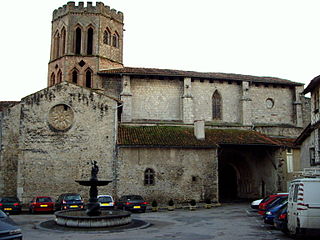
The former French Catholic diocese of Couserans existed perhaps from the fifth century to the French Revolution in the late eighteenth century. It covered the former province of Couserans, in south-west France. Its episcopal seat was in Saint-Lizier, a small town to the west of Foix. It was a suffragan of the archdiocese of Auch.

The Diocese of Bazas, centred on Bazas in Aquitaine, covered the Bazadais region, known under the Romans as the Vasatensis pagus after the ancient occupants, the Vasates. In the 2nd century it was part of the Novempopulania, one of the seventeen provinces of Gaul. The diocese must have been created between the first and the third centuries, but because of the large numbers of invaders that passed through this region - Arians, Saracens, Normans - the list of bishops is much reduced during the first millennium. The first bishop of this diocese is mentioned, without a name, by Gregory of Tours in his De gloria martyrum.

The Diocese of Dax or Acqs was a Roman Catholic ecclesiastical territory in Gascony in south-west France. According to tradition it was established in the 5th century. It was suppressed after the French Revolution, by the Concordat of 1801 between First Consul Napoleon Bonaparte and Pope Pius VII. Its territory now belongs to the Diocese of Aire and Diocese of Bayonne.

The former Roman Catholic Diocese of Oloron was a Latin rite bishopric in Pyrénées-Atlantiques department, Aquitaine region of south-west France, from the 6th to the 19th century.

The Diocese of Nevers is a Latin Church diocese of the Catholic Church in France. The diocese comprises the department of Nièvre, in the Region of Bourgogne.

The Diocese of Bayonne, Lescar, and Oloron, commonly Diocese of Bayonne, is a Latin Church ecclesiastical territory or diocese of the Catholic Church in France. It is a suffragan diocese in the ecclesiastical province of the metropolitan Archdiocese of Bordeaux. The diocese comprises the département of Pyrénées-Atlantiques, in the région of Nouvelle-Aquitaine.

The former French Catholic diocese of Apt, in southeast France, existed from the fourth century until the French Revolution. By the Concordat of 1801, it was suppressed, and its territory was divided between the diocese of Digne and the diocese of Avignon. Its seat was at Apt Cathedral, in Vaucluse.

The ancient residential diocese of Orange in the Comtat Venaissin in Provence, a fief belonging to the papacy, was suppressed by the French government during the French Revolution. It was revived in 2009 as a titular see of the Catholic Church.
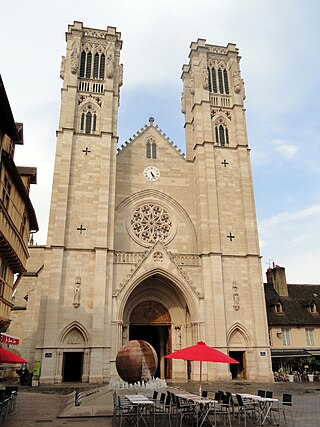
The former French Catholic diocese of Chalon-sur-Saône existed until the French Revolution. After the Concordat of 1801, it was suppressed, and its territory went to the diocese of Autun. Its see was Chalon Cathedral.

The Diocese of Pamiers, Couserans, and Mirepoix is a Latin Church diocese of the Catholic Church in southern France. The diocese comprises the department of Ariège and is suffragan to the Archdiocese of Toulouse. The diocese of Pamiers is divided into five Deaneries: Pamiers, Foix, Haut-Ariège, Couserans, and Pays-d'Olmes-Mirapoix. The episcopal see is the Cathedral of Saint Antoninus in the city of Pamiers.



















